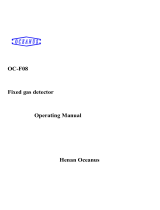
XNX Universal Transmitter Quick Start Guide
4
5 Options ����������������������������������������������������������������������������������������������36
5�1 Local HART® Interface �������������������������������������������������������������36
5�2 Relays ��������������������������������������������������������������������������������������36
5�3 Modbus �����������������������������������������������������������������������������������37
5�4 Foundation Fieldbus ���������������������������������������������������������������38
6 Powering the XNX for the First Time ������������������������������������������������ 39
6�1 XNX Units Configured for EC, mV, and IR (except Searchline
Excel) ��������������������������������������������������������������������������������������������������� 39
6�2 XNX IR Units Configured for Searchline Excel ����������������������40
6�3 Configuring the XNX Universal Transmitter ���������������������������42
7 The XNX Front Panel ������������������������������������������������������������������������� 43
7�1 Controls and Navigation ���������������������������������������������������������43
7�2 The General Status Screen ����������������������������������������������������� 43
7�3 Entering the Menu Structure ��������������������������������������������������45
7�4 Displaying Transmitter Information ����������������������������������������46
8 Gas Calibration Menu �����������������������������������������������������������������������46
8�1 Calibration �������������������������������������������������������������������������������47
8.1.1 Calibration Procedure ...................................................47
8.1.2 Zero and Span Calibration for XNX EC Sensors .........49
8.1.3
Zero and Span Calibration of XNX EC Hydrogen Sulfide (H2S)
Sensors ..................................................................................................... 49
8.1.4 XNX EC Sensor Operational Life .................................. 50
8.1.5
Zero and Span Calibration for MPD Sensors .........................50
8.1.6 MPD Flammable Sensor .............................................. 52
8.1.7 Cross Calibration procedure for MPD-CB1 .................52
8.1.8 Calibrating the 705/705HT ............................................55
8.1.9 Calibrating the Sensepoint/Sensepoint HT .................55
8�2 Functional Gas Testing (Bump Test) ���������������������������������������56
9 Sensor Data ��������������������������������������������������������������������������������������� 57
9.1 Operating and Storage Conditions for Performance Tested
EC Cartridges ................................................................................ 57
9.2 EC Sensor Performance Data, Factory Mutual Verified ......58
9.3 EC Sensor Performance Data, DEKRA EXAM Verified ..........59
9.4 Other EC Sensors ...................................................................60
10 XNX Catalytic Bead and IR Replacement Sensor Cartridges ������� 62
11 Warning Messages ��������������������������������������������������������������������������63
12 Fault Messages �������������������������������������������������������������������������������70
13 Informational Messages ������������������������������������������������������������������82
14 Control Drawings �����������������������������������������������������������������������������84
15 Certification Labels �������������������������������������������������������������������������91
16 Specifications ���������������������������������������������������������������������������������� 94
17 EC Declaration of Conformity ��������������������������������������������������������� 96
Table of Contents (cont’d)






















